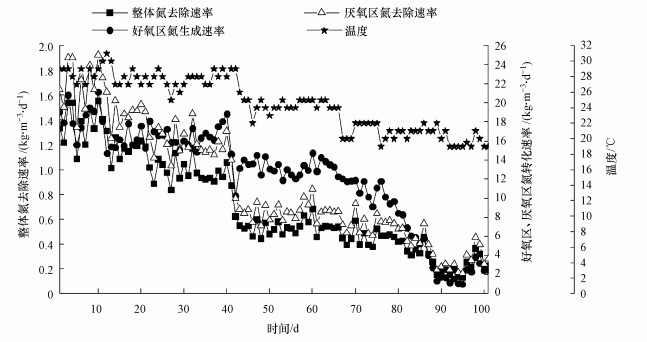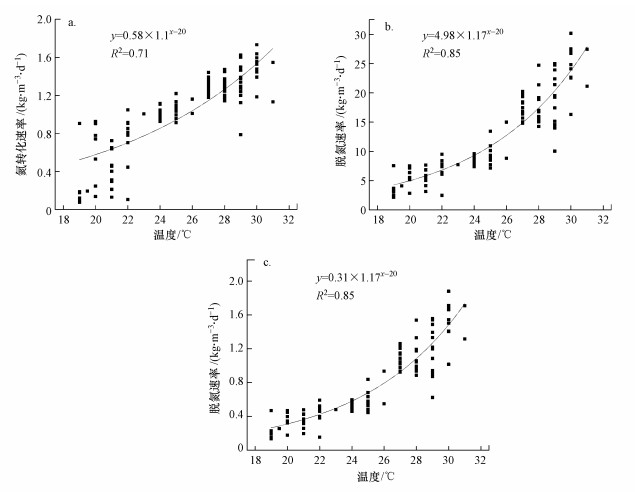2. 苏州科技大学环境生物技术研究所, 苏州 215009
2. Institute of Environmental Biotechnology, Suzhou University of Science and Technology, Suzhou 215009
部分亚硝化-厌氧氨氧化(PN-Anammox)作为一种新型的自养生物脱氮技术, 因具有脱氮效能高、不需要投加有机碳源、污泥产量低的优势, 一直受到研究者的广泛关注(Ali et al., 2015; Li et al., 2018a).随着PN和Anammox转化机理、功能微生物群落、控制参数等方面研究的不断深入, 诸多类型的PN-Anammox耦合工艺成功启动(Li et al., 2017; Kowalski et al., 2019), 并应用于诸如垃圾渗滤液(Li et al., 2018b; Yuan et al., 2019)、碱性蚀刻液(袁砚等, 2015)、污泥消化液(Wang et al., 2017; Yamamoto et al., 2011)等不同高氨行业废水的处理, 均获得了良好的脱氮效果.
PN-Anammox耦合工艺的功能微生物需要在30~35 ℃条件下才能发挥最优的耦合效果和脱氮效能(Ge et al., 2015; He et al., 2018).但一些工业没有余热可以利用, 因此, 在处理此类高氨废水时需要通过额外加热才能保证脱氮系统高效稳定的运行.崔剑虹等(2015)研究表明, 这部分能耗所需的成本不亚于采用传统生物脱氮工艺的处理成本.随着常温乃至低温条件下PN和Anammox反应器的成功启动, 关于PN-Anammox联合工艺常温成功启动的报道越来越多(Shannon et al., 2015; Wang et al., 2018).Lotti等(2014)在实验室反应器中利用颗粒污泥实现了PN-Anammox工艺在15 ℃环境下的运行.Hu等(2013)通过严密的过程控制实现了实验室小试PN-Anammox反应器在12 ℃下长期稳定运行.在这些常温启动PN-Anammox联合工艺的研究过程中, 一般采用直接常温启动或者通过阶梯型逐步降温的方式运行, 鲜有利用季节性温差变化实现非控温方式运行的PN-Anammox工艺的常温乃至低温运行.近年来, 主流PN-Anammox也在市政污水脱氮过程中受到关注(Laureni et al., 2019; Yang et al., 2018), 所谓主流条件除了考虑低氨氮浓度的特点以外, 还需要考虑季节性温度变化对PN-Anammox联合工艺脱氮的影响(Akaboci et al., 2018).因此, 在非控温的环境下, 研究季节性温度变化对PN-Anammox耦合工艺脱氮效能的影响对该工艺常温运行过程中的控制和主流条件下的运行具有一定的参考价值.
为此, 本研究采用具有自回流分区一体化反应器分别接种最适温度下富集的PN和Anammox微生物, 利用季节性缓慢降温, 研究温度变化对PN-Anammox工艺脱氮效能的影响, 并探究季节性温度变化对PN-Anammox工艺各区域脱氮效能的影响.以期为PN-Anammox工艺运用于常温废水的处理提供参考.
2 材料与方法(Materials and methods) 2.1 实验装置及运行条件实验装置由有机玻璃制成(图 1), 总有效体积为3.5 L, 主要包括部分好氧区2.8 L、厌氧区0.23 L和沉淀区0.47 L.在联合工艺的运行过程中, 利用好氧区曝气的尾气将沉淀区上清液回流至好氧区.亚硝化区的DO控制在0.5~0.7 mg·L-1, 由WTW在线监测仪监控.
 |
| 图 1 部分亚硝化-厌氧氨氧化联合工艺流程示意图 Fig. 1 Schematic of the partial nitritation-Anammox process |
好氧区接种亚硝化生物膜1 L, 来源于实验室的PN反应器.厌氧区接种Anammox颗粒污泥0.2 L, 来源于实验室长期运行的Anammox反应器.
2.3 废水组成采用人工配制废水, 主要组成为:NH4Cl (按需配制)、NaHCO3 1000 mg·L-1、KH2PO4 27 mg·L-1、CaCl2·2H2O 136 mg·L-1、MgSO4·7H2O 20 mg·L-1、微量元素Ⅰ1 mL·L-1和微量元素Ⅱ1.25 mL·L-1.微量元素浓缩液Ⅰ组分为:EDTA 5000 mg·L-1、FeSO4 5000 mg·L-1;微量元素浓缩液Ⅱ组分为:EDTA 5000 mg·L-1、ZnSO4·7H2O 430 mg·L-1、CoCl2·6H2O 240 mg·L-1、MnCl2·4H2O 990 mg·L-1、CuSO4·5H2O 250 mg·L-1、NaMoO4·2H2O 220 mg·L-1、NiCl2·6H2O 190 mg·L-1、NaSeO4·10H2O 210 mg·L-1和H3BO4 14 mg·L-1.
2.4 测定方法NH4+-N采用纳氏分光光度法(哈希2800, 美国)测定;NO2--N和NO3--N采用离子色谱法(戴安IS-9001, 美国)测定;pH、DO值和温度采用WTW在线监测仪(德国)测定.
2.5 实验方法首先通过配置人工模拟废水启动PN-Anammox联合工艺, 富集足够的功能生物量, 并达到稳定脱氮, 联合工艺的整体氮去除速率稳定在1.4 kg·m-3·d-1.然后在恒定氮容积负荷的条件下, 利用季节更替时环境温度的变化, 研究逐步降温对各区域脱氮能力的影响.因联合工艺具有自回流特征, 所涉及到的AOB菌和Anammox菌的氮素转化效能计算公式如下所示(Li et al., 2017):

|
(1) |

|
(2) |

|
(3) |

|
(4) |
式中, ΔN表示进出水总氮的差值(mg·L-1);[NH4+-Ninf表示进水NH4+-N浓度(mg·L-1);[NH4+-N]eff、[NO2--N]eff、[NO3--N]eff分别表示出水NH4+-N、NO2--N和NO3--N浓度(mg·L-1);HRTa、HRTana和HRTT分别表示好氧区、厌氧区和联合工艺总的HRT(d);NPRa表示好氧区NO2--N生成速率(kg·m-3·d-1);NRRana和NRRT分别表示厌氧区Anammox脱氮速率(kg·m-3·d-1)和联合工艺整体的脱氮效能(kg·m-3·d-1).
3 结果与讨论(Results and discussion) 3.1 季节性温度变化过程中PN-Anammox工艺的氮素变化反应器启动初期, 设定进水氨氮浓度为150 mg·L-1, 水力停留时间(HRT)设定为1.2 h, 氮容积负荷为2.7 kg·m-3·d-1左右.温度维持在30 ℃的条件下, 经过5 d的运行, 出水NH4+-N和NO2--N基本稳定在40 mg·L-1和10 mg·L-1.随后, 随着季节性的降温, 环境温度总体呈现出下降趋势(图 2).在进水NH4+-N浓度不变的条件下, 当温度由30 ℃降低到28 ℃时, 出水NH4+-N浓度由40 mg·L-1升高到60 mg·L-1, 当温度降低到25 ℃时, 出水NH4+-N浓度升高到100 mg·L-1, 说明出水NH4+-N浓度随着温度的下降而逐步提高.而出水NO2--N浓度在此期间并未随着温度下降而逐步下降, 而是出现明显的累积, 从10 mg·L-1逐步上升到30 mg·L-1.当温度降低到20 ℃时, 出水NH4+-N浓度进一步增大到128 mg·L-1, 同时出水NO2--N浓度逐步下降到5 mg·L-1.NO3--N浓度由10 mg·L-1逐渐增大到20 mg·L-1.Fux等(2002)研究表明, 温度低于24 ℃时, 亚硝化菌(AOB)的最大生长速率比硝化菌(NOB)的最大生长速率低.因此, 该现象表明此时NOB开始增长, 以AOB为主导的优势生长环境被打破, 导致Anammox菌缺乏NO2--N作为营养底物.
 |
| 图 2 PN-Anammox联合工艺各区域氮素转化 Fig. 2 Nitrogen conversion of each region in PN-Anammox combined process |
随着季节性温度变化, PN-Anammox工艺各区域的氮素转化速率变化如图 3所示.在反应器运行前15 d, 当温度由30 ℃降低到28 ℃时, 联合工艺的整体脱氮速率平缓下降, 由1.4 kg·m-3·d-1下降到1 kg·m-3·d-1, 与此同时厌氧区脱氮速率由23 kg·m-3·d-1下降到18 kg·m-3·d-1;反应器运行到40 d, 环境温度降低到25 ℃时, 联合工艺的整体脱氮速率下降幅度较大, 由1 kg·m-3·d-1下降到0.5 kg·m-3·d-1, 厌氧区脱氮速率也开始明显下降, 由18 kg·m-3·d-1下降到9 kg·m-3·d-1;温度低于25 ℃时, 联合工艺的整体脱氮速率的下降幅度不大, 厌氧区脱氮速率的下降幅度也趋于平缓.当温度由30 ℃降低到22 ℃时, 亚硝化区的氮转化速率下降幅度不大, 由1.3 kg·m-3·d-1下降到0.9 kg·m-3·d-1;反应器运行到86 d, 温度由22 ℃降到20 ℃时, 亚硝化区的氮转化速率开始明显下降, 由0.9 kg·m-3·d-1下降到0.2 kg·m-3·d-1, 此时联合工艺的脱氮速率也有所下降, 下降幅度并没有那么明显, 联合工艺的脱氮速率在温度下降过程中主要由Anammox过程限制.
 |
| 图 3 温度对PN-Anammox联合工艺各区域脱氮效能的影响 Fig. 3 Effect of temperature on nitrogen removal efficiency in various regions of PN-Anammox combined process |
有研究表明, Anammox菌对温度的冲击更敏感(De Clippeleir et al., 2013; Ge et al., 2015).低温易使Anammox菌细胞膜呈凝胶状而阻碍营养物质的跨膜运输, 导致细胞因“饥饿”而降低活性(李祥等, 2012).付昆明等(2012)研究发现, 当温度从35 ℃骤降至21 ℃时, Anammox活性降低59.24%, 而AOB活性仅降低8.01%;当温度从35 ℃骤降至15 ℃时, Anammox活性大幅下降, 降低了82.99%, 而AOB活性降低25.62%.张杰等(2009)在研究温度对CANON工艺的影响时发现, 温度在20 ℃时对CANON工艺中Anammox效能的影响很大, 而对亚硝化效能的影响较小, 从而造成NO2--N的大量积累;而在15 ℃时, CANON工艺的亚硝化效能也开始受到严重影响, 使得NO2--N积累减少, 但温度对Anammox的影响依然比对亚硝化的影响大.本实验中温度随着季节变化而逐渐降低, 温度下降到25 ℃时对联合工艺的Anammox效能的影响很大, 而对亚硝化效能的影响较小.当温度下降到20 ℃时, 联合工艺的亚硝化效能也开始受到严重影响.
3.3 PN-Anammox工艺各区域脱氮效能与温度的关系运用Origin软件, 通过Arrhenius公式对联合工艺整体脱氮速率及各个区域脱氮速率与温度的关系进行非线性拟合, 结果如图 4所示.由图 4a可知, 亚硝化区氮转化速率与温度经过拟合得到y=0.58×1.10x-20, R2=0.71.如图 4b所示, 厌氧区的脱氮速率与温度的拟合关系为y=4.98×1.17x-20, R2=0.85.亚硝化区的R2较小, 说明温度对亚硝化区的脱氮速率具有一定的影响, 厌氧区的R2较大, 说明温度对厌氧区的脱氮速率的影响更为明显.由图 4c可知, 联合工艺整体脱氮速率与温度经过拟合得y=0.31×1.17x-20, R2=0.85, 与厌氧区的R2接近, PN-Anammox联合工艺整体脱氮速率的温度特征系数是1.17. Tao等(2012)研究发现, 联合工艺脱氮速率的温度特征系数是1.23, 与本实验的结果差距不大.
 |
| 图 4 温度对亚硝化效能(a)、Anammox脱氮速率(b)及联合工艺的脱氮速率(c)影响的拟合曲线 Fig. 4 Fitting curves of the influence of temperature on nitrification efficiency(a), nitrogen removal rate of Anammox(b) and nitrogen removal rate of combined process(c) |
本研究结果中厌氧区的脱氮速率的温度特征系数比亚硝化区氮转化速率的温度特征系数大, 这也表明温度对Anammox的效能影响更大.Vázquez-Padín等(2011)研究表明, 在相同的DO浓度下, 温度的降低会增加氧气穿透深度, 从而导致有氧区的比例增大.虽然亚硝化和Anammox过程的活化能相似(约70 kJ·mol-1) (Dalsgaard et al., 2002), 理论上温度的降低对两个过程的固有速率的影响类似, NO2--N生成和消耗之间的平衡不会受到影响.然而Anammox过程会受到温度降低和缺氧比例减小的双重影响, 活性降低更为明显, 从而限制联合工艺的脱氮效能.
3.4 PN-Anammox工艺控温策略温度下降对PN-Anammox工艺中微生物活性的负面影响已经获得广泛共识, 然而如何根据温度变化规律调节PN-Anammox工艺, 保证稳定脱氮, 尤其在非控温的环境下调控变得尤为重要.依据本研究结果可以看出, 温度在25 ℃以上时, 主要由于Anammox菌活性因降温而下降, 从而导致整体工艺脱氮效能下降.而当温度持续降低时, 除了Anammox菌活性不断降低外, AOB活性也将逐步下降, 同时NOB活性逐步增强, 除导致亚硝化效能下降以外, 还会导致NO2--N累积率下降.因此, 针对季节性温度的变化, 可考虑在高温季节高负荷运行, 保证足够的微生物量, 以保证低温季节能够高效运行.或者根据温度变化, 在25 ℃以上时采用流加污泥的方式向PN-Anammox联合工艺中增加Anammox菌, 而当温低于25 ℃时, 再逐步流加亚硝化污泥.
4 结论(Conclusions)1) 采用季节性环境温度下降, 逐步驯化适应低温运行的PN-Anammox联合工艺是可行的, 但温度对联合工艺的影响很大.
2) 运用Arrhenius公式对联合工艺整体脱氮速率及各个区域(PN和Anammox)脱氮速率与温度的关系进行非线性拟合, 特征系数分别为1.17、1.10和1.17, 表明温度对Anammox的效能影响更大, 联合工艺的脱氮速率由Anammox过程限制.
Akaboci T R V, Gich F, Ruscalleda M, et al. 2018. Assessment of operational conditions towards mainstream partial nitritation-anammox stability at moderate to low temperature:Reactor performance and bacterial community[J]. Chemical Engineering Journal, 350: 192–200.
DOI:10.1016/j.cej.2018.05.115
|
Ali M, Okabe S. 2015. Anammox-based technologies for nitrogen removal:Advances in process start-up and remaining issues[J]. Chemosphere, 141: 144–153.
DOI:10.1016/j.chemosphere.2015.06.094
|
崔剑虹, 李祥, 黄勇. 2015. 部分亚硝化-厌氧氨氧化工艺联合形式、应用及脱氮效能评析[J]. 化工进展, 2015, 34(8): 3142–3146.
|
Dalsgaard T, Thamdrup B. 2002. Factors controlling anaerobic ammonium oxidation with nitrite in marine sediments[J]. Applied and Environmental Microbiology, 68(8): 3802–3808.
DOI:10.1128/AEM.68.8.3802-3808.2002
|
De Clippeleir H, Vlaeminck S E, De Wilde F, et al. 2013. One-stage partial nitritation/anammox at 15℃ on pretreated sewage:feasibility demonstration at lab-scale[J]. Applied Microbiology Biotechnology, 97(23): 10199–210.
DOI:10.1007/s00253-013-4744-x
|
Fux C, Boehler M, Huber P, et al. 2002. Biological treatment of ammonium-rich wastewater by partial nitritation and subsequent anaerobic ammonium oxidation (anammox) in a pilot plant[J]. Journal of Biotechnology, 99(3): 295–306.
DOI:10.1016/S0168-1656(02)00220-1
|
付昆明, 张杰, 曹相生, 等. 2012. CANON反应器运行稳定性及温度冲击的影响[J]. 环境科学, 2012, 33(10): 3507–3512.
|
Ge S, Wang S, Yang X, et al. 2015. Detection of nitrifiers and evaluation of partial nitrification for wastewater treatment:A review[J]. Chemosphere, 140: 85–98.
DOI:10.1016/j.chemosphere.2015.02.004
|
He S, Chen Y, Qin M, et al. 2018. Effects of temperature on anammox performance and community structure[J]. Bioresource Technology, 260: 186–195.
DOI:10.1016/j.biortech.2018.03.090
|
Hu Z, Lotti T, de Kreuk M, et al. 2013. Nitrogen removal by a nitritation-anammox bioreactor at low temperature[J]. Applied and Environmental Microbiology, 79(8): 2807–2812.
DOI:10.1128/AEM.03987-12
|
Kowalski M S, Devlin T, di Biase A, et al. 2019. Accelerated start-up of a partial nitritation-anammox moving bed biofilm reactor[J]. Biochemical Engineering Journal, 145: 83–89.
DOI:10.1016/j.bej.2019.02.015
|
Laureni M, Weissbrodt D G, Villez K, et al. 2019. Biomass segregation between biofilm and flocs improves the control of nitrite-oxidizing bacteria in mainstream partial nitritation and anammox processes[J]. Water Research, 154: 104–116.
DOI:10.1016/j.watres.2018.12.051
|
Li J, Li J, Gao R, et al. 2018a. A critical review of one-stage anammox processes for treating industrial wastewater:Optimization strategies based on key functional microorganisms[J]. Bioresource Technology, 265: 498–505.
DOI:10.1016/j.biortech.2018.07.013
|
Li X, Yuan Y, Wang F, et al. 2018b. Highly efficient of nitrogen removal from mature landfill leachate using a combined DN-PN-Anammox process with a dual recycling system[J]. Bioresource Technology, 265: 357–364.
DOI:10.1016/j.biortech.2018.06.023
|
Li X, Huang Y, Yuan Y, et al. 2017. Startup and operating characteristics of an external air-lift reflux partial nitritation-ANAMMOX integrative reactor[J]. Bioresource Technology, 238: 657–665.
DOI:10.1016/j.biortech.2017.04.109
|
李祥, 黄勇, 郑宇慧, 等. 2012. 温度对厌氧氨氧化反应器脱氮效能稳定性的影响[J]. 环境科学, 2012, 33(4): 1288–1292.
|
Lotti T, Kleerebezem R, Hu Z, et al. 2014. Simultaneous partial nitritation and anammox at low temperature with granular sludge[J]. Water Research, 66: 111–121.
DOI:10.1016/j.watres.2014.07.047
|
Shannon J M, Hauser L W, Liu X, et al. 2015. Partial nitritation anammox in submerged attached growth bioreactors with smart aeration at 20 degrees[J]. Environmental Science:Processes & Impacts, 17(1): 81–89.
|
Tao W, He Y, Wang Z, et al. 2012. Effects of pH and temperature on coupling nitritation and anammox in biofilters treating dairy wastewater[J]. Ecological Engineering, 47: 76–82.
DOI:10.1016/j.ecoleng.2012.06.035
|
Vázquez-Padín J R, Fernández I, Morales N, et al. 2011. Autotrophic nitrogen removal at low temperature[J]. Water Science & Technology, 63(6): 1282.
|
Wang G, Xu X, Zhou L, et al. 2017. A pilot-scale study on the start-up of partial nitrification-anammox process for anaerobic sludge digester liquor treatment[J]. Bioresource Technology, 241: 181–189.
DOI:10.1016/j.biortech.2017.02.125
|
Wang Y, Gong B, Lin Z, et al. 2018. Robustness and microbial consortia succession of simultaneous partial nitrification, ANAMMOX and denitrification (SNAD) process for mature landfill leachate treatment under low temperature[J]. Biochemical Engineering Journal, 132: 112–121.
DOI:10.1016/j.bej.2018.01.009
|
Yamamoto T, Wakamatsu S, Qiao S, et al. 2011. Partial nitritation and anammox of a livestock manure digester liquor and analysis of its microbial community[J]. Bioresource Technology, 102(3): 2342–2347.
DOI:10.1016/j.biortech.2010.10.091
|
Yang Y, Zhang L, Cheng J, et al. 2018. Microbial community evolution in partial nitritation/anammox process:From sidestream to mainstream[J]. Bioresource Technology, 251: 327–333.
DOI:10.1016/j.biortech.2017.12.079
|
Yuan C, Lu C, Ma Y, et al. 2019. A novel method to treat old landfill leachate combining multi-stage biological contact oxidation (MBCO) and single-stage autotrophic nitrogen removal using anammox and partial nitrification (SNAP)[J]. Chemical Engineering Journal, 359: 1635–1643.
DOI:10.1016/j.cej.2018.10.233
|
袁砚, 李祥, 周呈, 等. 2015. PN-ANAMMOX一体化反应器处理电子行业PCB废水[J]. 环境科学, 2015, 36(7): 2591–2596.
|
张杰, 付昆明, 曹相生, 等. 2009. 序批式生物膜CANON工艺的运行与温度的影响[J]. 中国环境科学, 2009, 29(8): 850–855.
DOI:10.3321/j.issn:1000-6923.2009.08.013 |
 2019, Vol. 39
2019, Vol. 39


